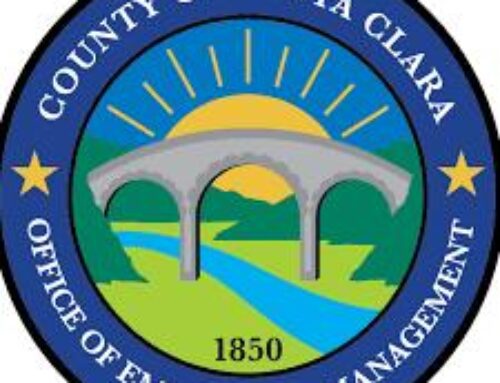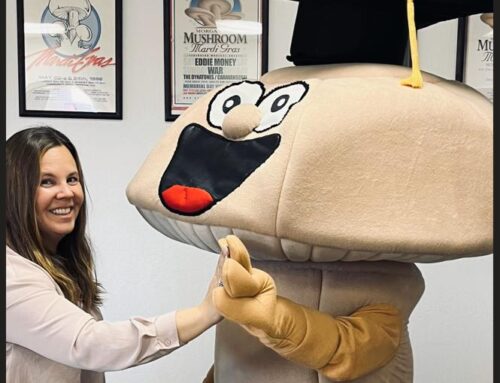Garage plays role in getting investment in downtown’s future
Published in the March 16- 29, 2016 issue of Morgan Hill Life
By Marty Cheek

Photo by Robert Airoldi
Brad Seabourne with F & H Construction installs the spider art on the south wall of the new parking garage.
Months before workers moved the first shovel-load of dirt to begin construction on the downtown parking garage, “The Tarantula” proved a point of contention for the $12-million project. Some residents feared the 12-foot artistic representation of a Henry W. Coe State Park spider might make people too terrified to come downtown. Others balked at the $165,000 price tag.
On the morning of March 3, as a small group of locals held their phone cameras up for photos and video, workers on a construction crane installed The Tarantula on the Fourth Street side wall of the nearly completed garage. The delicate red metal legs of the giant entomological jewel, a work of public art made with hundreds of vintage vehicle headlights by world renown artist Gordon Huether, seemed to claw toward the rooftop. Among the 25 or so citizens watching were some who were pleased with the appearance of the new arachnid art — and some who felt otherwise.
The Tarantula, as well as a “poppy jasper” glass wall also by Huether that will soon be installed on the Third Street side of the garage, are key components to the successful inclusion of the three-story, 275-space parking structure into the downtown. And the garage itself will play an important role in making the downtown more visitor friendly, with hopes that more residents and out-of-towners will visit the city’s central district and patronize the many restaurants and retail stores.
“The spider, in addition to some of the other public art in downtown, helps to catalyze the culture of downtown,” said John Lang, economic coordinator for Economic Development for the city. “Public art is a way to engage the community — you can like it, you can hate it, but it’s a way to engage the community. It creates community dialogue. People will be talking about The Tarantula.”
As the city of Morgan Hill put together its Downtown Placemaking Investment Strategy a couple of years ago, it brought in an art consultant to get art grants and get artists interested in Morgan Hill and create an engagement in arts and culture, said Edith Ramirez, principal planner for Economic Development for the city. The consultant encouraged a mini-grant program to accent the downtown with locally-produced art as well as pushing that an artist be involved in the parking garage team to create interesting artistic components to the structure. The contract finally went to the lowest bidder, Lodi-based F&H Construction.
“They happened to have a strong partnership with Gordon Huether, who is an internationally recognized public artist. They had worked with him before, so they brought him in as part of this team,” Ramirez said. “F&H brought an incredible artist to the table with an incredible vision for art for this facility.”
The emergence of new public art work such as The Tarantula, the poppy jasper glass wall, the deer family sculpture and other recent additions to the downtown is creating a sense of place and uniqueness that will draw more visitors to Morgan Hill, said John McKay, a Planning Commissioner and president of the Morgan Hill Downtown Association. The Third Street Plaza now being installed immediately outside the garage adjacent to Huntington Restaurant & Sports Pub will also open that area to more use, with whimsically designed tables and benches and WiFi access, he added.
“You’re going to be walking out into a very lively, energized setting,” he said. “I think it’s going to instantly create a social gathering place and it’s going to have this real positive energy. You’re going to be surrounded by wonderfully cool things.”
The city and local merchants hope the parking garage will turn into a “gateway” for people who might be visiting from outside the area, he said, with the giant Tarantula art hanging overhead the first thing many out-of-towners discover about the downtown when they drive into the garage. This will help in setting a fun tone to their visit from the start, he said. The newly built garage will also drive visitors to downtown because people in the past have expressed frustration with the ability to find parking close to merchants, he said.
Much thought went into the details of the garage’s design, Ramirez said. The Third Street side has space built into it for a large retail shop adjacent to the plaza. Parking will include 275 full-sized spaces for cars, including several with electric charging stations. Bike lockers have also been included in the garage design for cyclists to find a safe and convenient place to store their wheels. Way-finding signs will help visitors navigate to nearby restaurants, stores and the Community and Cultural Center. Walls on the various levels will be accented with the red and gold colors of poppy jasper. And half of the roof-top level of the garage has been reinforced so that large public events such as concerts and fund-raising parties can be held high in the sky where guests can enjoy spectacular views of the city and surrounding hills and mountains.
“It’s not just a parking structure. It’s a facility that fits well into the downtown,” Ramirez said. “The garage parking is going to be free. That is a tremendous asset for the downtown businesses. The design of the garage is bright. We brought in a design consultant to make sure they supported our review of the garage in the colors and everything else, so I think it’s rather a beautiful garage.”
Lang had previous experience working as an economic consultant for the city of San Jose and from that job he recognized the necessity of providing convenient parking to enhance the economic viability of a downtown district. He’s impressed that Morgan Hill’s parking garage is “ideally located in central downtown” which will make it easy for people to find their way to explore not only the shops and restaurants north of the garage but some of the businesses and the Community and Cultural Center along Monterey Road south of the structure. The historic Grange Hall on Fourth Street across from the garage might also gain increased use for concerts and parties as people discover it when they drive into the structure, he said.
“We need the garage. It’s a key piece in supporting development and hopefully it will help in growing people’s interest in downtown,” Lang said. “It really is an access point to all these activities, to the north, to the south, to the east, and eventually to the west to the hilltop trail (up Nob Hill).”
The garage has played an important role in getting developers interested in being part of downtown Morgan Hill’s future. In May, work is expected to begin on the development of a quartet of restaurants on Third Street and Monterey Road, the site where the Pop-up Park is now located. The authentic Greek restaurant Opa!, Mo’s… the Breakfast & Burger Joint, steakhouse Willard Hicks and upscale street taco diner Tac-Oh! have proven their popularity in other communities of the Bay Area such as Los Gatos, Willow Glen, Palo Alto and Mountain View. Now they are coming to downtown Morgan Hill.
Developer Frank Leal last year purchased the Downtown Mall and Granada Theater site a block north. He intends to build a boutique hotel and conference center to draw high-end overnight visitors and corporate training programs to the downtown.
“We’re so lucky if we can ensure that we capture the momentum to help Frank Leal execute on the boutique hotel for downtown,” Ramirez said. “I think it will be a game changer for us.”
Other developments that have been influenced by the construction of the garage include City Ventures’ project along Depot and Second streets which will create a vertical mixed-used project of retail and lofts. And Weston-Miles Architects is developing a 30-unit “stacked” condominium project on Depot Street and Main Avenue.
Directly on the east side of the garage is undeveloped property owned by Glenrock Builders owner and Morgan Hill resident Rocke Garcia. This land is still a work in progress and it’s uncertain what will be built there, Ramirez said.
“We know he continues to be interested. We want to be able to continue to work with him to execute on that project,” she said. “I think what’s going to be critical for the district and probably useful for Rocke Garcia is the City Ventures project across the street that is similar in terms of size and magnitude and being able to see City Ventures create a vertical mixed-use project.”
Also adding to the new experience of downtown are the high quality of public art works now emerging. Noel Resnick and her business partner Tim Clott of Napa Valley-based Partners2Media videorecorded interviews for a documentary of The Tarantula during its March 3 installation. They said they saw an enthusiasm by many citizens for Huether’s piece built for the garage. His name connected to the piece will draw art lovers from around the Bay Area.
“Gordon is very innovative and he is well renown,” Resnick said. “And whenever there is something challenging and interesting to participate in, you’ll always find Gordon in the forefront. And he was actually the perfect artist to be a part of this because everything he does, the big installations, are bigger than life, they’re colorful, they start a conversation.”
When it opens this month, the parking garage will serve as a crucial “anchor” to the renaissance of Morgan Hill’s downtown economy as well as the city’s ability to attract more businesses and developers, Lang said.
“The community is very invested in the development of downtown and I think that passion will drive the investment in downtown,” he said. “It’s always good to take this kind of enthusiasm when we meet with businesses that are entertaining the idea of coming to Morgan Hill, we can turn around and say, ‘Look, this community is enthusiastic. We want you here. It’s a great community to be involved in.’”
Lang pointed at the people who had gathered to watched workers placing The Tarantula on the garage wall and said the attention is an indication of the interest residents have of the vision for the downtown and the rest of the city.
“I’ve been very impressed with the community engagement and involvement,” he said, describing how the artwork connects the “nature” elements of the region with the future development of downtown. “It’s the story of Morgan Hill. There’s more to it than just being on a garage. There’s history to it. And as we communicate that story, it changes the perception of what Morgan Hill is. Those are the stories we want to be telling.”










